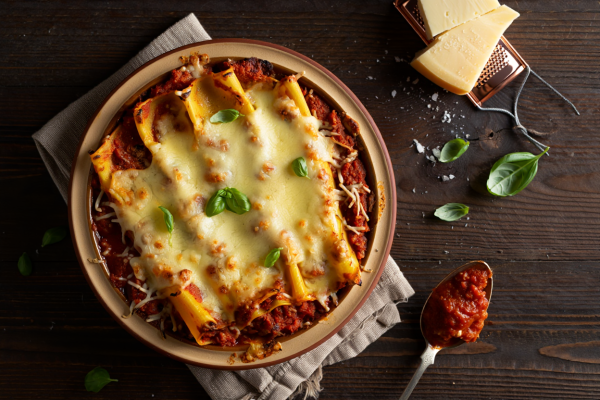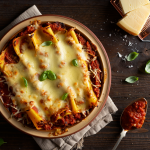
Baking Lasagna and Layering Risk: Don’t Rush the Sauce
May 26, 2025
There’s something almost meditative about the act of baking lasagna. The kitchen fills with an earthy and expectant aroma, a promise slow-cooked into each careful layer. To the uninitiated, lasagna seems simple—pasta, sauce, cheese, repeat. But anyone who’s truly tried knows: the difference between mediocrity and majesty lies in the details. The sauce, in particular, is a crucible of patience. Every instinct urges you to turn up the heat, to hurry its thickening, to pour it over noodles before it’s ready. But haste here is a saboteur; it yields a watery, insipid base that seeps through the dish, robbing the whole of its structure and soul.
The paradox is immediate: lasagna is a dish layered with anticipation, yet it punishes impatience. Its heart is alchemy, not assembly. The vegetables must sweat, the tomatoes must yield their sharpness, the meat must surrender its fat. And then, only then, do the flavours fuse into something worthy of the next layer. There’s a discipline required—one that is part science, part instinct, and wholly human. You stir, you wait, you taste, you adjust. You fail, sometimes. The sauce splits, burns, or refuses to reduce. You learn, and you return, and you try again. This is the quiet psychology of the kitchen: an arena of risk, reward, and resilience, disguised as domestic routine.
The Slow Transition: Lessons Bubbling Beneath
What does it mean to not rush the sauce? It’s more than culinary advice—it’s a philosophy of sequencing, of respecting process over product. When you bake lasagna, you’re forced to confront your own impulses. Do you dare to wait? Can you resist the urge to shortcut, to stack noodles while the sauce is still thin, to skip the simmer in pursuit of speed? Every decision is a wager, every shortcut a gamble with consequences that only emerge later, when you cut the first slice and watch the layers slide apart or stand tall.
A mirror appears in the gentle chaos of bubbling pots and scattered utensils. The traits that surface in the kitchen—patience, timing, adaptability—are not culinary quirks; they are universal currencies of risk. The kitchen, like the market, is a crucible of uncertainty. The difference is only one of scale and stakes. The same psychological architecture underpins all: anticipation, anxiety, decision, and consequence.
The Recipe: Lasagna for the Long-Term Strategist
What you need:
Fresh pasta sheets (layered foresight)
Slow-cooked beef ragù (deep value fundamentals)
Béchamel sauce (smooth capital flow)
Grated mozzarella and parmesan (diversified flavour assets)
Olive oil & garlic (aromatic catalysts)
Salt, pepper, fresh basil (risk management)
How to build:
Start with a foundation — one ladle of ragù into your baking dish. Real strategy begins at the base.
Layer with intent — pasta sheet, ragù, béchamel, cheese. Repeat. Every layer is an investment cycle.
Don’t rush the stacking — patience compounds flavour.
Top it off with a final béchamel and a bold sprinkle of cheese. Go all-in.
Bake at 180°C (356°F) for 40–45 minutes. Watch for bubbling edges and golden returns.
Rest for 10 minutes before serving. Great portfolios — and lasagnas — settle before they shine.
Lasagna done right is not fast food.
It’s a strategic allocation of flavour, timed heat exposure, and disciplined layering.
Serve warm. Eat slowly. Think long-term.
Layering Risk: Markets, Memory, and the Architecture of Decision
Consider the market traders—sifting through data, hunting signals, layering positions. The parallels to lasagna-making are more than poetic; they are structural. Each investment is a layer, resting on the foundation of previous choices. And just like in lasagna, the temptation to rush—to enter a trade before the setup is complete, to pile on risk without a sturdy base—is a siren song. But markets, like sauces, are indifferent to your impatience. They punish the reckless with the same inevitability as a watery lasagna.
Both domains demand an understanding of timing, not as clock time, but as readiness. In lasagna, it is the slow thickening of sauce; in markets, the patient wait for volatility to contract or expand, for momentum to build, for sentiment to reveal its true face. This is why great chefs and great traders alike trust the process over the product, the preparation over the prize. The kitchen and the market both reward those who can sense when to act and when to hold back, who can feel the groove of the cycle rather than fight it.
Subtopic I: The Art of Patience—Sauce and Sentiment
Patience is not passive. In both baking lasagna and navigating markets, it is an active, often agonising discipline. The sauce that is hurried tastes raw, its acids unchecked and its sweetness undeveloped. Similarly, the investor who jumps at the first sign of movement—buying US equities at the crest of euphoria or selling in a panic—rarely enjoys a satisfying outcome. Patience is the art of waiting for the right moment, and—crucially—recognising it when it arrives.
This is not just about holding back; it is about being present for the details. The slow stir of a sauce is mirrored in the slow accumulation of information, the daily observation of price action, the calibration of risk. The best traders, like the best cooks, cultivate a kind of patient vigilance. They are not idle; they are attentive, attuned to the signs that something is ready to move, to transform.
Subtopic II: Layering Complexity—Structure, Sequencing, and Resilience
Lasagna is nothing if not a lesson in structure. Each layer must support the next, and a weak base undermines the entire dish. The same is true of portfolios. Risk is not a monolith; it is layered, diversified, hedged, and sequenced. The wise investor does not throw capital blindly into the market, just as a wise cook does not dump all ingredients into a pan and hope for the best.
Instead, they build carefully. A core of stable, dividend-paying stocks might form the pasta sheets—solid, reliable, enduring. Above that, a layer of growth equities, offering spice and excitement but also more volatility. Between these, a suite of options or alternative assets, designed to bind the whole and manage liquidity. Each element has its own role, its own risk profile, its own optimal timing. And just as lasagna improves when left to rest—when the heat of the oven has faded and the layers settle into coherence—so too does a portfolio benefit from periods of inactivity, of letting positions mature and risks resolve.
Subtopic III: Adaptation and Intuition—Reading the Room, Reading the Market
No recipe survives first contact with reality. The tomatoes are riper than expected; the oven runs hot; the cheese is saltier than remembered. Similarly, no market playbook is immune to surprise. Economic data confounds expectations, geopolitical risks flare, liquidity evaporates. The ability to adapt—quickly, calmly, without panic—is what separates the amateur from the master in both kitchen and market.
But adaptation is not randomness. It is guided by intuition, itself the product of long exposure and deep attention. The seasoned chef knows, by scent and sound, when the sauce is on the verge of burning. The veteran trader senses, sometimes wordlessly, when sentiment is about to snap—when fear is about to turn into opportunity, or greed into collapse. This is not magic; it is the muscle memory of risk, honed through repetition, failure, and reflection.
Subtopic IV: The Paradox of Control—Letting Go to Gain Mastery
Both lasagna-making and investing confront us with the paradox of control: you must guide the process, but you cannot dictate the outcome. The sauce may resist thickening; the market may defy your thesis. There is a humility in both crafts—a recognition that you can only do so much, that the rest is up to forces beyond your command.
And yet, mastery lies in this dynamic tension. The chef does not abandon the stove, but neither does she bully the sauce into submission. The trader sets stops, sizes positions, runs scenarios—but does not cling to outcomes. In both cases, the willingness to let go—to accept uncertainty, to release attachment to a specific result—is what opens the door to genuine skill. This is the quiet confidence that comes from experience: the knowledge that, win or lose, you have played the game well.
Full Circle: Elevating the Everyday, Illuminating the Unseen
When you next stand at the stove, coaxing flavour from the flame, remember: you are not just cooking. You are practising an ancient form of risk management, a meditation on patience, structure, adaptation, and humility. The lessons learned in the kitchen travel with you—into markets, boardrooms, and every domain where uncertainty and ambition collide.
The secret is not to rush the sauce, nor the trade. It is to respect the process, to build your layers with care, to remain vigilant and adaptive, and finally, to let go of the illusion of perfect control. In doing so, you transform both lasagna and risk into something greater than the sum of their parts—a layered triumph, resilient and deeply satisfying.
That first slice is always a revelation. Not because it is flawless, but because you have earned it. In the kitchen, as in the markets, the reward belongs to those who wait, who watch, who dare to layer risk with patience and precision. Don’t rush the sauce. Don’t rush the market. The best things, always, reveal themselves in their own time.











They can enforce federal law or go to federal jail for obstruction of justice.
No fed funds for YOU!